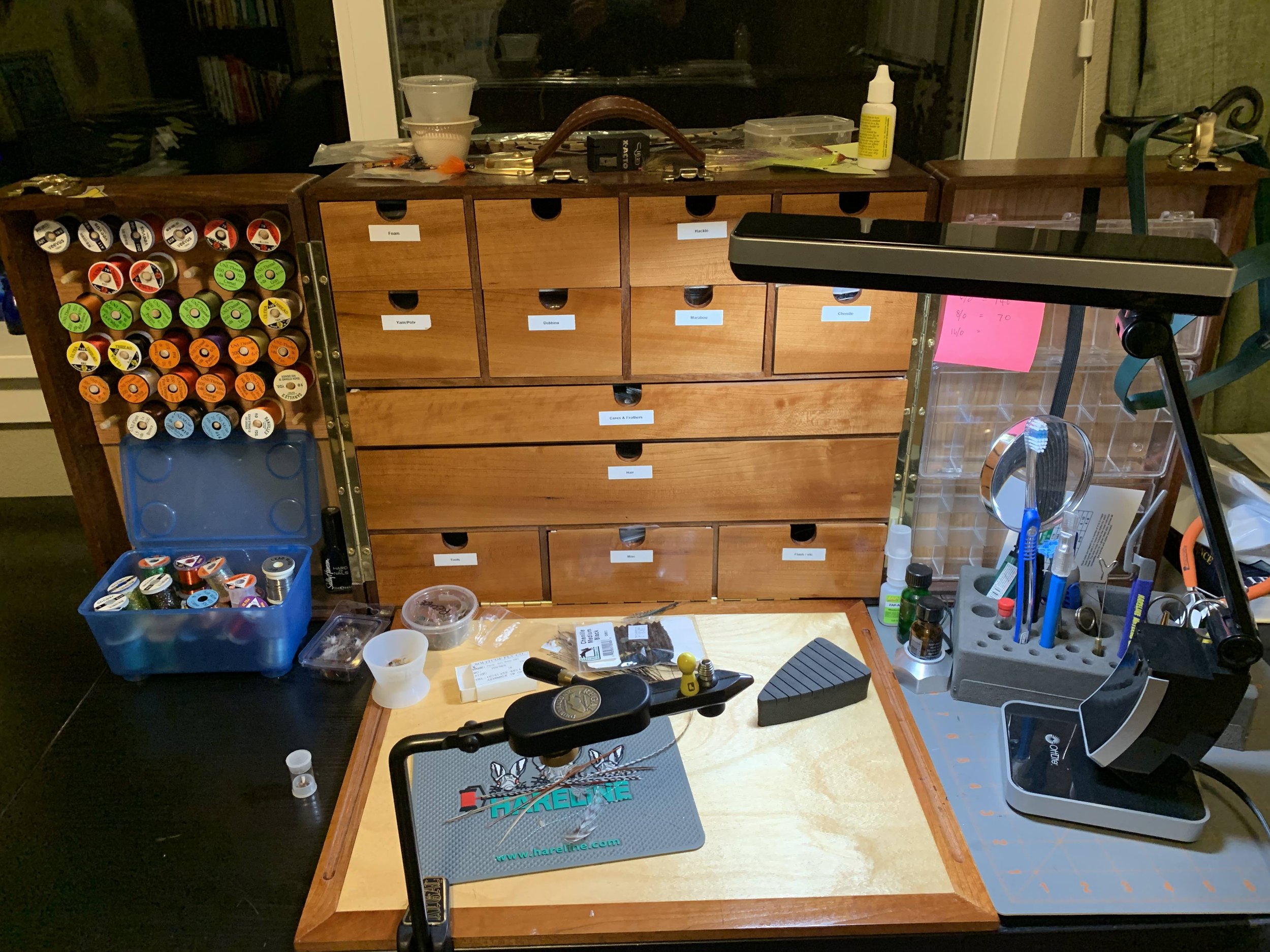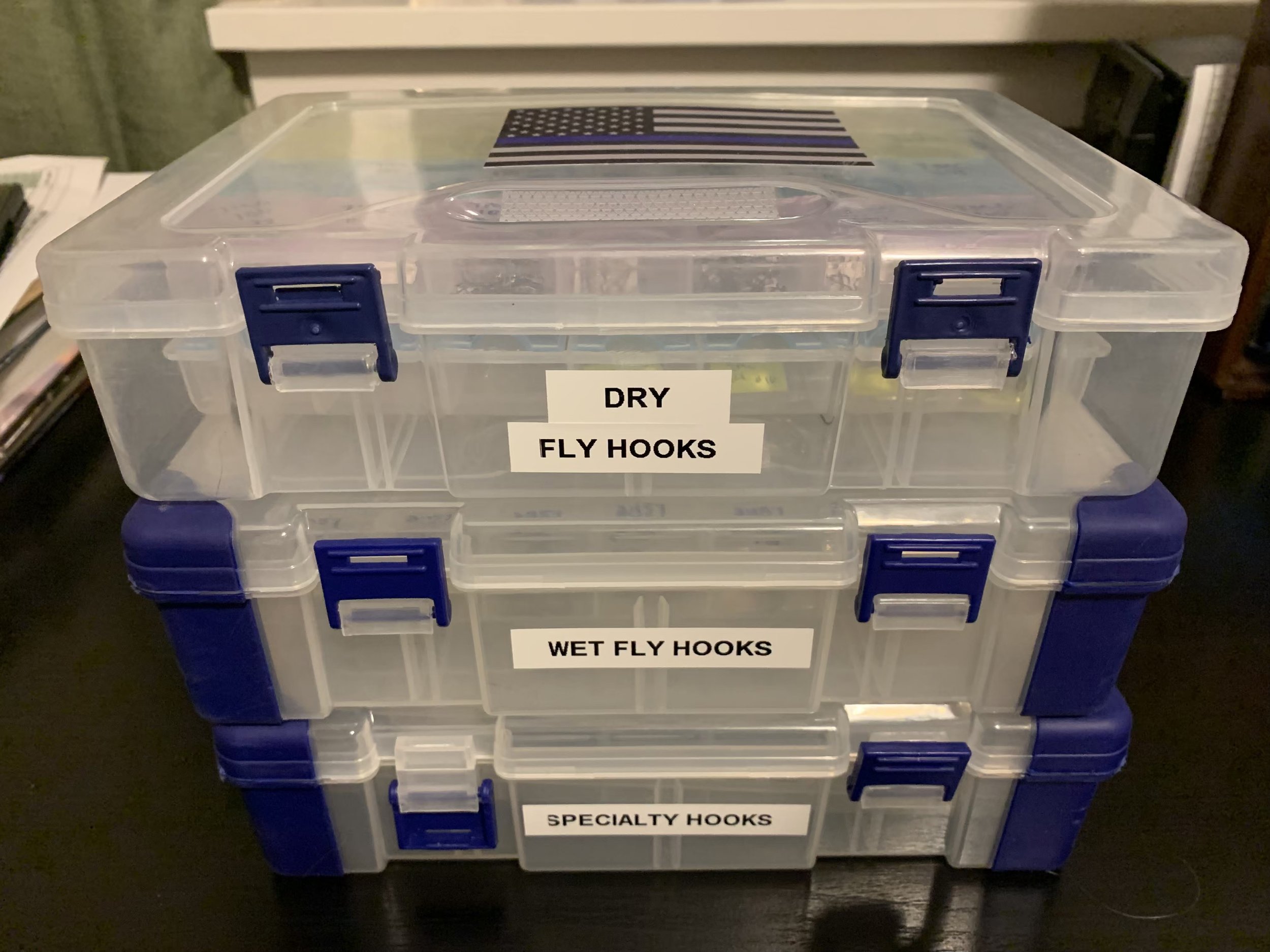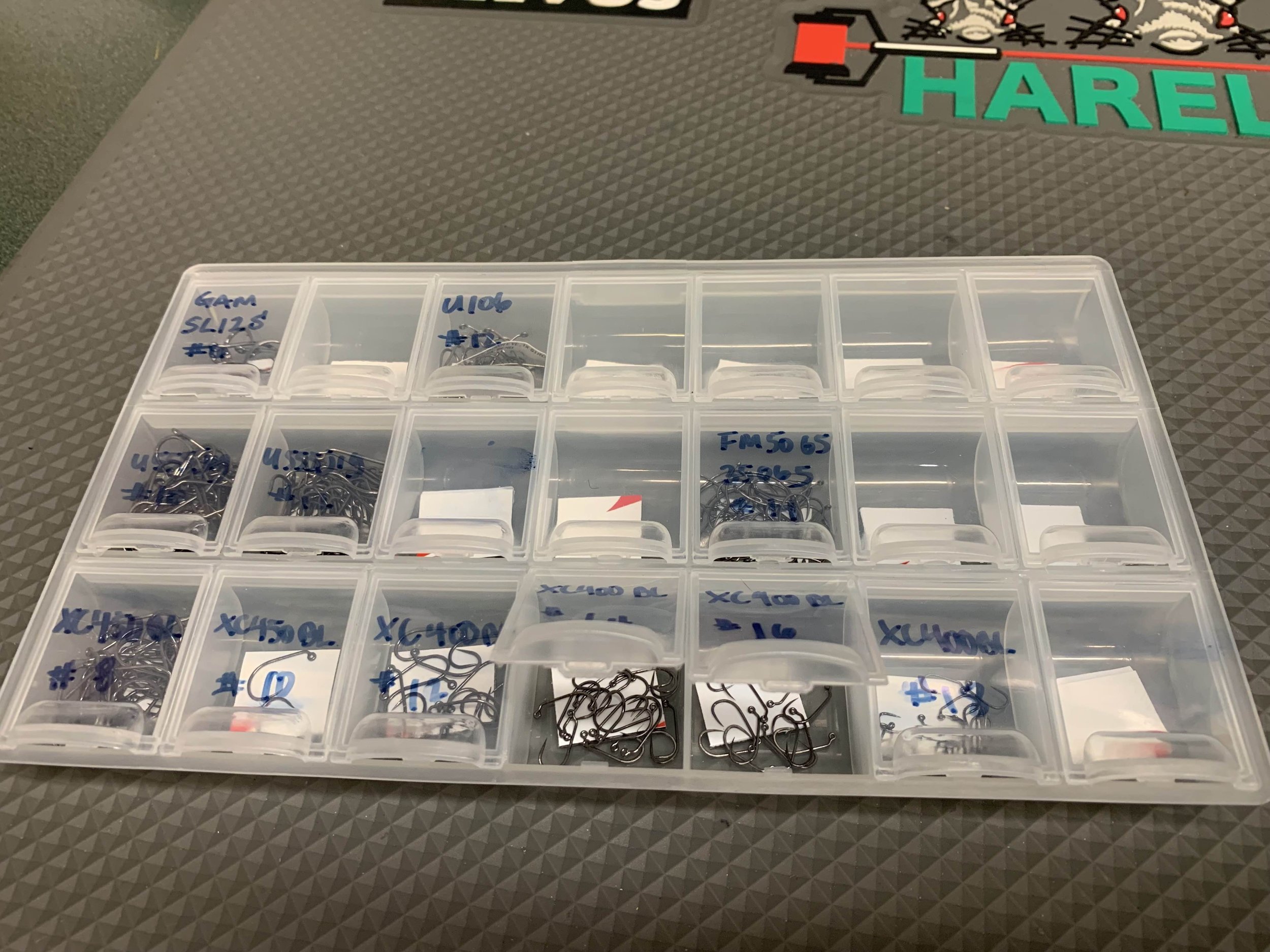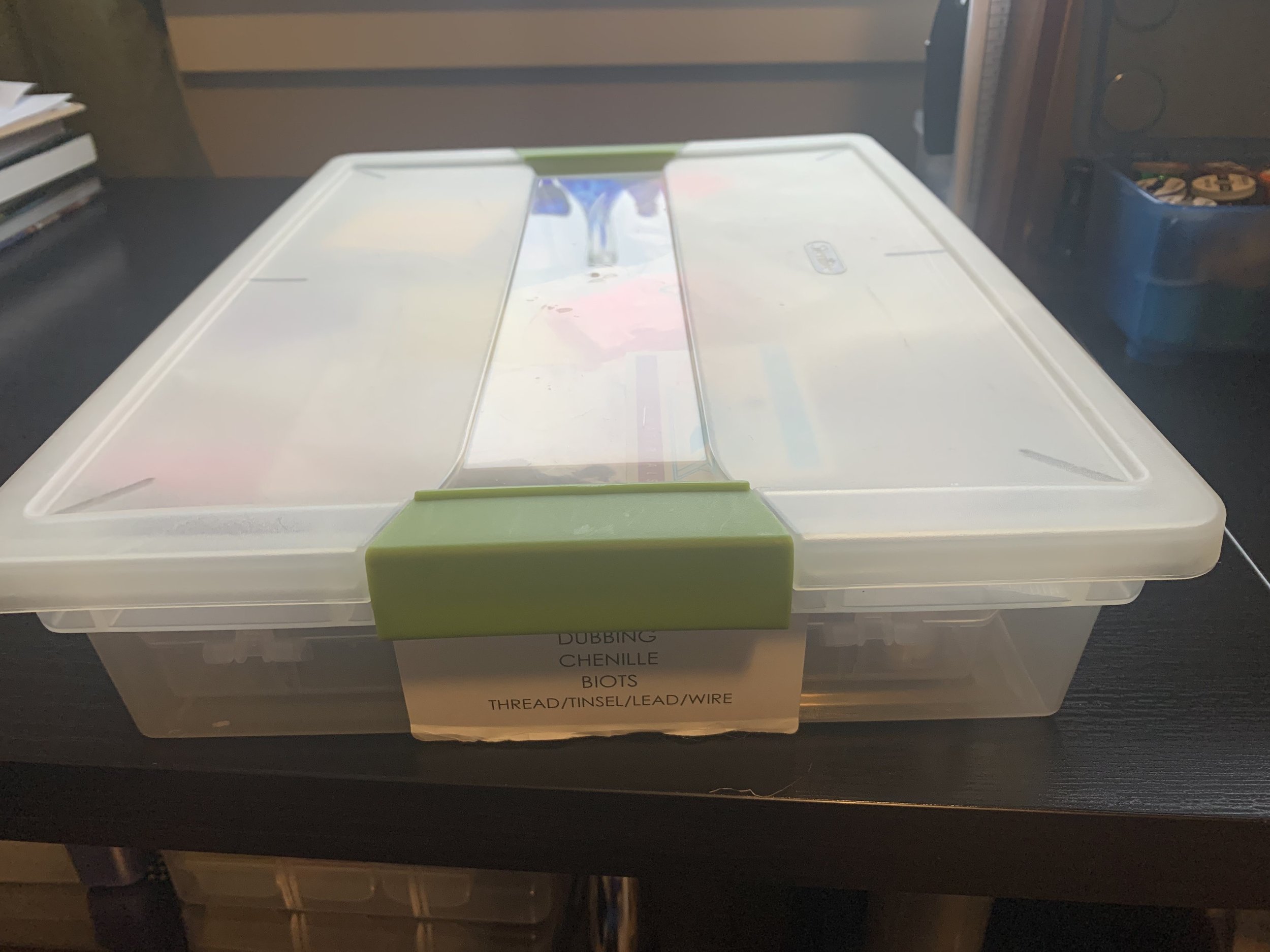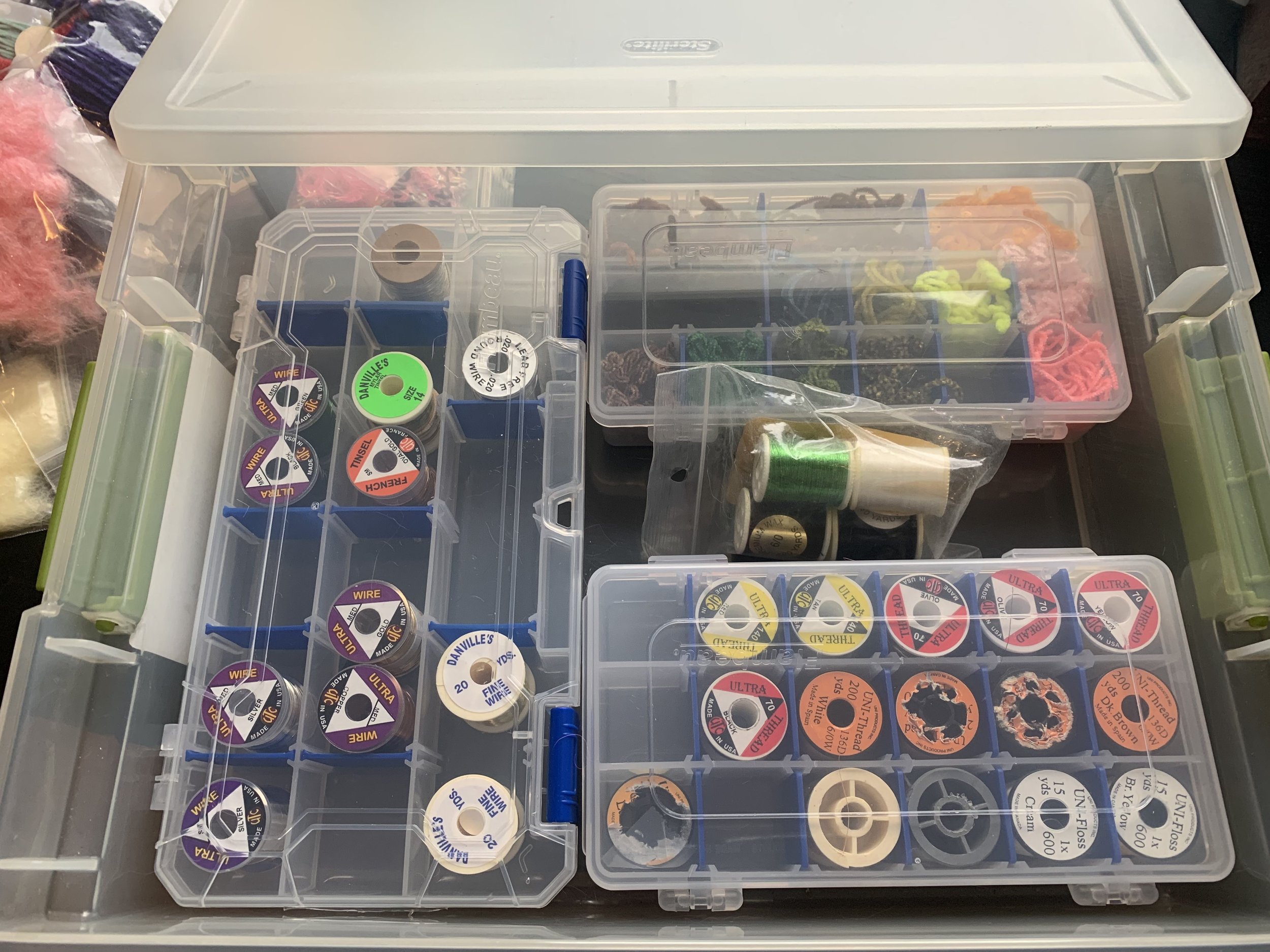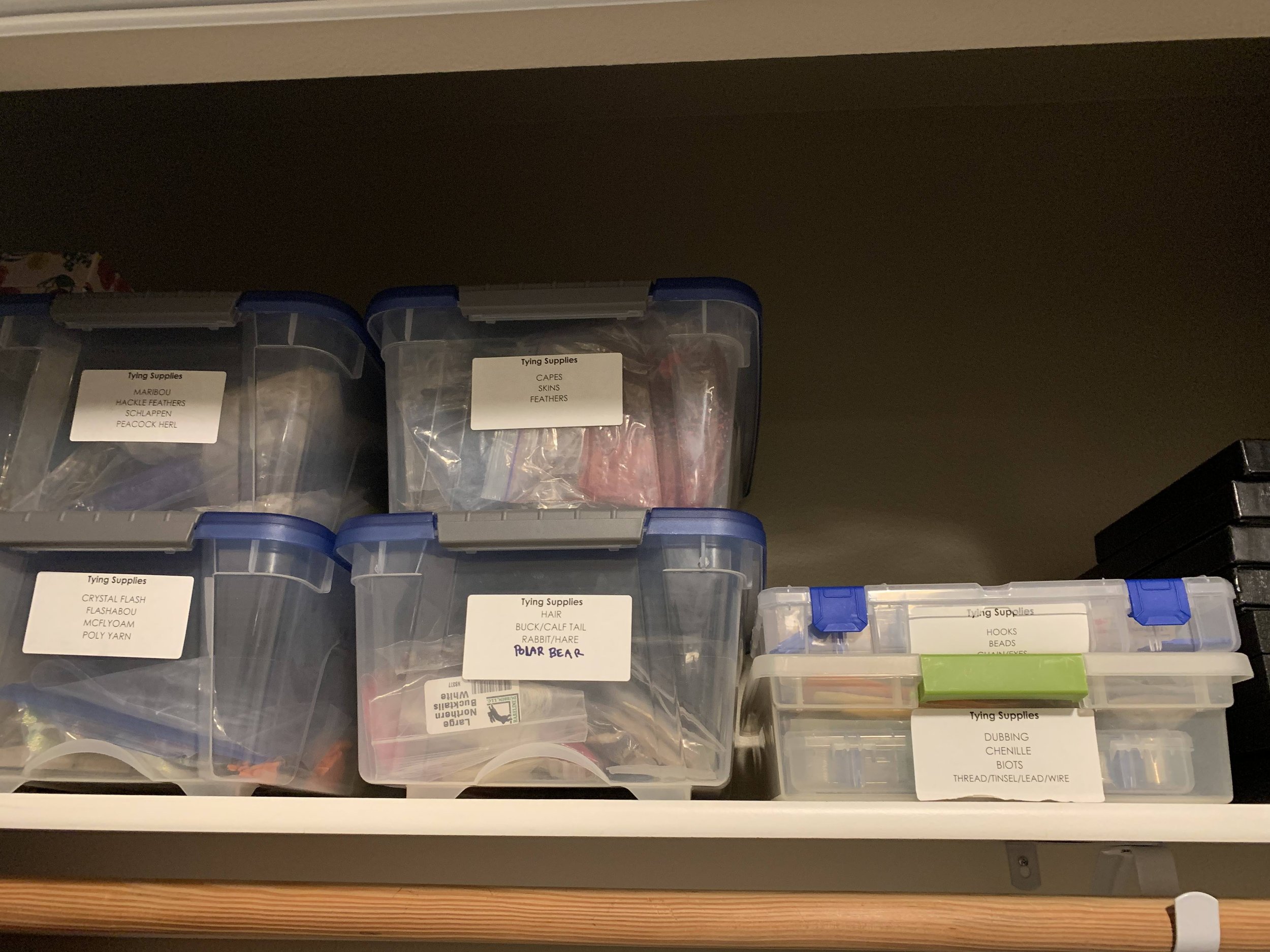Winter Fly Fishing
Fly fish all year with this information.
A lot of people ask me if I fish all year long, meaning, do I fish in the winter months. I'm usually taken aback by this question because of course I fish in the winter. Then I realize most people are fair weather anglers and maybe they just never considered fishing in the winter. Either way, in this blog I'm going to try and take some of the mystery out of winter fishing and offer you insight into what you need to know about the colder fishing months in the Willamette Valley.
I follow several social media pages where I often see people asking where they can go to catch fish. It seems that they want someone to tell them where, when, and how to catch the fish rather than do the work needed to do it themselves. Sometimes another member gives them a tip but often they’re told to, “Just go.” Now this can be frustrating for those of you who may fall into the above category, but I'm here to help you learn when and where to go fishing in the winter, in general.
As a fly fishing guide I've spent innumerable hours on the back roads, in the woods and along the rivers and lakes in search of the best waters to fish. I wont say that it's been a struggle since I love being out and in the presence of nature, but it does take time. I realize not everyone has a lot of that, time, when they have to work and raise families. So here we go, some secret guide intel coming your way.
During the late fall and into early spring, water is falling and rising. Rain, the thing that makes our valley so beautiful and productive becomes our nemesis. What I mean is rain causes the river levels to be in flux all the time making wading (and floating) more of a challenge or impossible. It also affects the insects that fish eat as well as fish behavior. The colder the water, the less fish feed. It also ques fish to move to better holding lies both to lessen the water’s push on them which requires more energy and to seek warmer water.
In addition to the rain, we get hit with cold air temperatures which affect the water temp (think bugs and fish) and our own abilities to be outside withstanding it. High pressure systems bring in colder air and raise the barometer which further complicates our winter fishing strategies. Combine the two, cold rainy days, and not many folks want to go seek out fish with lock jaw while their hands and feet freeze.
My goal here is to point you to some resources that will help you identify places and times that could be “optimal” to fish while sitting in the comfort of your own home. You’ll save a lot of time, stay warm and probably learn a few skills to use all year long. Here we go-
Where to go fishing - Resources:
When you know what the river levels should be for you to wade safely you can sit in the comfort of your own home and look at a few websites to ascertain if fishing might be good. I have three websites that I refer to frequently when deciding if it’ll be worth me driving to the river and layering up for a few hours.
USGS National Water Dashboard- https://dashboard.waterdata.usgs.gov/app/nwd/en/?aoi=geolocate-25
NOAA National Weather Service- https://water.weather.gov/ahps/region_forecast.php?state=or
local weather forecast
The USGS National Water Dashboard, a useful site that will let you look at any number of water gages across the USA. I set the parameters to a 50 mile x 50 mile area around my home and check several locations to see what the levels are. Once you learn what the upper and lower water levels are for your favorite streams you can save yourself a lot of traveling to “go look”. You should also look for water temperatures here; many gauges have this as an option. You can also research past levels up to one year. There’s so much information on this site that they’ve provided tutorials to help you use it. https://help.waterdata.usgs.gov/tutorial
The second website I use is the NOAA National Weather Service site. I typically look at the “river forecast” and drill down to view Oregon. From there I can look at my favorite streams and gages to see what NOAA is predicted to happen over the next few days. There’s a huge array of data you can review here and a great way to lose a few hours going down a rabbit hole or two.
And finally, I check the local weather forecast on my phone. It's not important which one you use, you just want to know what the general conditions will be in the area you’re considering fishing. When you gather information from all three resources, you can paint a fairly accurate picture of what the river conditions will be on any given day within the upcoming week. And this my friends is how you decided WHERE to go fishing.
Here’s what to look for:
-water levels allowing you access
-steady or falling water levels (fish aren't happy with rising water)
-water temps that improve your chances at catching fish (45-60 are best)
-weather you can personally tolerate
All of these factors are variable and depend on your personal level of physical and mental comfort. For example, I'm confident wading the MF Willamette below the NF gauge when the water level is below 3500 cfs. If I check the gauge and it's at or below that 3500 cfs, it’s not pouring rain, and I can drive there safely, I'm probably going to go fishing.
HOW TO STAY WARM - Layering:
When you know you’ll be warm and comfortable on the water, even during winter, you're more likely to get out there and give it a go. The outdoor industry has come a long way in developing materials that are lightweight, warm, and comfortable. If you're an outdoor enthusiast and have some tech clothing, it can probably serve double duty as winter fishing apparel. The number one rule is, NO COTTON! Cotton absorbs sweat/moisture and holds it against your skin whereas wool or the tech fabrics wick it away and allow for evaporation. Here’s how I stay warm in the winter, while wading.
Beginning with your feet, you’ll need two layers since your wader’s stocking feet don't breathe. Start with a 100% synthetic sock/liner followed by a mid weight wool blend sock. Make sure you're not crammed in your wader’s stocking foot and wading boots as this can decrease circulation and warmth. You can also add “Lil Hotties” for the feet or buy heated socks if you prefer
Next up is your lower/upper body. Start with a base layer of polypropylene or wool blend against your skin; you want it to “breath” and absorb the moisture you’re going to generate. Next comes the insulating mid layer of fleece under your waders. And lastly, for your upper body you can add a down or synthetic vest or jacket. Depending on the weather, you may need your waterproof wading jacket. Besides repelling rain and snow, it's a great wind blocker.
Hands are important and there are lots of options including wool blend fingerless gloves, “Lil Hotties” in your pockets, nitrile gloves under wool gloves, etc. Find something that works for you and helps make the day enjoyable. Ultimately, you’ll have to sacrifice your fingers to the cold to manage the rod and line, but remember to take time out to warm them up occasionally.
TACTICS:
So now you’ve found a run to fish and you’ve got the right clothing to be out in the cold weather. You might be wondering what the fish are eating and where they might hold in the water. Trout do move around based on water level, temperature and food sources. In the colder months they move into deeper runs and pools where the water flow is easier to hold in and a little bit warmer allowing them to use less energy. Most trout won’t move very far to eat due to the cold so you have to be more precise in getting the flies to them. Don't overlook water that’s moving slowly, walking pace, and 2-4’ deep; this can be a mecca for trout.
As for what trout are eating in the winter, think small. Blue Wing Olives (BWO) and midge patterns in a size #18 - 22 are my go to patterns. With less sunlight and colder water temps the hatches are less frequent and the bugs are generally small. It’s a rare day in winter when you can fish dry flies, but some of my most memorable winter trout have come that way. It's amazing to see noses breaking the surface on a cold January day as the fish gorge. Be prepared with a few dry flies but pack a decent selection of nymphs because, “This is the way.” (from “The Mandalorian”)
You should be tuned up on your nymphing game (rigs, casting) for winter fishing. Either traditional indicators or tightline nymphing tactics are great options for our local waters. Tightline nymphing will allow you a more precise delivery of your nymphs but also necessitate you to be closer in proximity to where you want to fish. Indicator nymphing can be accomplished while not having to wade in as much. In my opinion, one is not better than the other and both have their place on the water. Nymphing rods can also be used for fishing streamers and dry flies if you know how to set them up but that's a topic for another day.
There are myriad nymphs scuttling around the substrate throughout the year, and winter is no exception. Most of a trout’s diet is going to be on mayfly and stonefly nymphs. These insects take anywhere from 1-7 years to mature so imagine the varying food opportunities for trout. I carry #6-10 stonefly patterns, #14-18 Mayfly/caddis, a several attractor patterns in the #14-18 range. Oh, and don't leave home without a few soft hackles and streamer patterns.
Time of day is an important factor to consider. In winter there’s no need to get up at the crack of dawn unless you're steelhead fishing. Trout eat throughout the day but are more keyed in when the bugs are moving around and this is dictated by sunlight and temperature. Plan for a midday/afternoon fishing session based on weather patterns and water temps. You can find this information by using the resources above.
So now you have a lot of information at your fingertips, literally, to make winter fly fishing a cinch. If you get out on the water and play around with different set ups, flies and depths, you’re sure to catch something, even if it's only a good time. Don't be intimidated or think too much about it, just GO FISH.
Let’s get organized: Fly Tying
Here’s my suggestions for organizing your fly tying materials.
My fly tying desk
I’m one of those “strange” people; I like to organize and make lists. Last year I decided to go through my fly tying materials and tools because I kept buying duplicate materials when I couldn’t find a particular something I wanted in my stash. After I acquired three packs of olive marabou I sat down and created a Google Sheets inventory document that I store on my Google Drive; accessible from any fly shop, yard sale, or tying event via a cell phone. And yeah, I usually update it when I bring home my latest purchase or garage sale find; usually…(rolling eyes)
I was pretty shocked as I started the process, pawing through my hook drawer. I found many boxes of old Mustad hooks that I wasn’t likely to use (nothing wrong with them but I prefer newer models) and multiple packs of the same hooks. So, I began by sorting them into dry and wet versions, adding a “specialty” category for Euro jig, big streamers and assorted other odd balls. From there I narrowed each version down to brand and model numbers and then size. Example: Wet- TMC 3761 #14-16. I did the same for the dry fly and specialty hooks, too.
My next dilemma was how to store the hooks. I opted to use bead containers from Fire Mountain Gems. I don’t recall how I came across the containers but what I found is perfect for this purpose. They are plastic storage boxes that hold two slightly smaller boxes with 21 snap lid compartments. I labeled all the compartments using a Sharpie with hook model and size. And to keep the hooks a bit more secure in the individual compartments, I cut up the magnet pads from the manufacturers hook bags and glued them inside. Here are the links to the carrying case and snap lid hook compartments:
https://www.firemountaingems.com/itemdetails/H203243PK and https://www.firemountaingems.com/itemdetails/H203932PK
All told, there are 42 individual compartments for hooks in each storage box. I ended up with three boxes (2 trays each) for a total of 126 hook slots. Now, I haven’t filled them all up yet so don’t roll your eyes at me.
Next up was the thread, wire and other synthetic materials on spools. I keep the most common colors and sizes at my bench on a dowel board. The extra spools are kept in small Flambeau storage boxes that perfectly fit the standard fly tying thread/wire spools. When I use up a spool or need a uncommon color, I just pull down the box and check for what I need. I keep them in another snap lock box and pile extra chenille and dubbing on top.
I use quite a few beads, from tungsten to glass. Again, I keep the majority of them in a drawer of the craft cart at my desk since they get used frequently. In order to differentiate the various types (slotted, tungsten, cyclops, etc) I use Loon bench rings. I punch a hole at the top of the baggy they come in and then thread the plastic coated wire ring through. I have a ring of each type organized by color and size/weight. Since I take the paper packaging with information off, I use a pen and write the size/weight on each bag for reference.
For extra hair, feathers, and synthetic materials I use plastic snap lock totes from Costco that stack neatly. I store them in the closet in my tying room where I can get to them easily. I separated marabou, schlappen, capes and hackle and the likes, since I have a lot of them and they take up a good amount of space. This way I can just pull down a particular tote and paw through it for what I’m looking for rather than digging around in a giant bin. Pro Tip: make sure to use a resealable bag for all your buck tail so you don’t stink up all of your other materials! Be sure to seal the totes up too; pesky little bugs will find their way in and ruin your stash.
Extra material stored in totes and labeled
The key to making my tying sessions productive and fun is to have the right materials available AND accessible. To help with this, I use the craft cart drawers, in addition to the tying desk, to keep the most commonly used feathers, fur, marabou, chenille, dubbing and tools at my disposal. When I had to hunt for materials in several different locations and then dig around under other stuff I ended up annoyed and wasting a lot of time. Now I’m organized and happy, and my materials are stored neatly and are safe from the cats and bugs.
Craft cart stored under tying bench with frequently used materials
So you might wonder what to do when you want to tie flies at camp, or go to a tying event away from home. There are a lot of commercial “fly tying travel kits” available to purchase but I’ve found my 30+ year old plastic tool box works great (and it was practically free). This was my prized possession after graduating college and earning my Athletic Trainer Certification back in 1993. All my tape and first aid equipment used to reside inside. Now it’s transporting my vise, tools, materials; everything I need to tie a few patterns away from my tying desk. Some friends just toss everything in a Rubbermaid tote and go, others put it in a canvas grocery tote. I encourage you to experiment and decide what you prefer.
Here’s hoping my OCD with lists and organization will inspire you to sort through your materials and tools. If you find you’ve got three lifetimes of some materials, don’t hoard it all. Consider passing it on to a friend or new tyer who is sure to appreciate it. Personally, I find being able to try new materials or the latest trend in the market fun when I justify it by not having “too much” at home already.
Happy Organizing!
PRIDE
Over the past few weeks I’ve had the opportunity to interact with some amazing people. It started when a friend and I met up for a bagel at our favorite place far away from the mainstream. It was a Thursday at 10:00am and we expected to have the little neighborhood joint mostly to ourselves. When I arrived my friend had snagged the last table and was waiting on me to order, which we promptly did. I was disappointed because they were out of my favorite flavor, salt. Uh huh, if you havent tried a salt bagel, you’re missing out! I settled for an asiago bagel with cream cheese, tomato and red onion. Mmmm good!
As we waited with the masses, I mean like 10+ people were waiting for to go orders and all the tables were full and waiting (another 10+ people) for food. Where did these folks come from and why weren’t they at work so we could have the place to ourselves? It was then I noticed an elderly woman with a cane attempting to open the door. Another patron helped her with the door and she made her way to the counter and ordered. Afterwards she took up a standing room only position near the coffee prep bar. She stood there with her coffee mug searching for an available seat, looking a little hunched and tilted. I noticed a guy sitting at a two top on his phone, he was waiting for a to go order, but he never looked up or didn’t care that she might need a seat. So, without mentioning it to my friend, I spoke up and offered the woman our table . When my friend realized what I’d done, she again offered our table; the woman refused. So my friend instead insisted the woman come and join us since we had an extra chair.
To be honest, I was a little disappointed at having an interloper; concerned we’d struggle to have conversation, and our meet up would be awkward. To my surprise the morning was a beautiful exchange of conversation between two 50 somethings and a 94 year old woman who was still independent, witty, curious and connected to all that’s going on everywhere. Turns out, she’s the publisher or a well known local newspaper.
That brings me to last Saturday, the day I showcased True North Fly Fishing to the LGBTQ community at the EugPride Festival. Representation and inclusion are important in helping us all better realize who and what we can become. And we know that minority/marginalized groups are still underserved by mainstream organizations. Not to say that my tiny little fly fishing guide business is mainstream, but fly fishing is, albeit, it’s a tiny percentage of the overall fishing industry. As both a woman, and a gay woman at that, it’s been hard at times to break into the field. Sometimes it was just the fear of being rejected, at other times it was the fear of physical harm. By that I mean going into a male dominated business and asking for information and also being alone in the outdoors and being vulnerable.
Because of those fears, I wanted to represent to others that there are safe spaces for all of us to enter the arena of flyfishing. I wanted to be that person others can see and say to themselves, “She looks like me.” and, “Look what she’s doing, I want to do it, too.” I can check the boxes for woman, gay, and in my 50’s. If I can do it, so can you!
There are still times I feel vulnerable in a fly shop or out on the river, but at my age I’m not giving into the fear anymore. Yes, I’m cautious but I also know my mental and physical limits and hover on the edge of pushing my limits these days. I’m holding my own space and at the same time as trying to create space for others to experience the healing properties of nature and the joy of fish and water.
I really enjoyed meeting Anita at the bagel shop. She showed me that you can age gracefully, maintain your independence and still hold meaningful conversation with the younger generation. She gave me hope that I wont be an “old grandma” to my grandkids, instead a hip cool woman who keeps them on their toes. I also enjoyed meeting and talking to all the amazingly unique people who stopped by my booth at EugPride to chat about fly fishing. I really liked all the, “Oh, fly fishing! I’ve always wanted to try that.” comments. Yes, you can try it, you can be awesome at it and I welcome you. I know my allies in the local fly fishing community would also love to get to know you and help you feel safe and welcome.
I can’t wait to meet you at a fly casting lesson or take you out to the river to dip your rainbow colored toenails into the water while fishing for beautiful trout.
LET’S FISH!
Welcome!
Beautiful places make memories.
I’ve been wanting to share my adventures in flyfishing, and the outdoors, for a long time. I hope you enjoy the trip with me. In this space I plan to share random trail ramblings as well as my thoughts on fish conservation, ecology, random mushrooms, and all that comes with spending time on the water. Now what to start with…
Have you heard of the “imposter syndrome” or the “confidence gap”? I experienced both of these while climbing the ladder of two career paths over the last 30 years. What I know now is, I was often the expert or most experienced person in the room and I failed to recognize it. Or maybe I did, but because others didn’t express their support of me I presumed otherwise. I think women often compensate for this by feeling they “have to work twice as hard” to get the respect they deserve when in reality they would’ve bene given respect if they had only acknowledged their expertise in themselves first. When it comes to my fly fishing experiences I often felt the same way; that I didn’t know much or posses skills worth sharing. I’m sorry to say it’s taken me many years to figure all of this out and overcome the issues; or have I? So you might wonder what those terms have to do with being a fly fishing guide; well, let me tell you.
When I was 23 and finishing college I considered being an outdoor recreation guide. It was the early 90’s and the field was exploding (so was micro brew) and I wanted in. I loved to hike, backpack, mountain bike, fish, anything outdoors, and I wanted to share it with others. The internet wasn’t a thing yet so in order to get into the field one had to get their foot in the door by approaching companies doing the work, which were local, male dominated, and few and far between. Well, I was way too intimidated to think that I could push the door open on a male dominated field and take people on outdoor adventures. I’d already been rejected so many times before in other areas that I just didn’t have the energy or confidence to try. So, I went quietly into my field of study and became a recreational user of the lands like most of us.
Fast forward 32 years and two careers in male oriented professions and you have found me, Carolyn, the owner of True North Fly Fishing. Through those many years I discovered myself, although it wasn’t an easy process, and feel established in my beliefs and values. I also found both strong women and courageous men who were willing to support me, actually encourage me, to pursue my dream all these years later. I’ve reached the point in my life now where I will challenge the “establishment,” whatever it may be, and hold space for women and other minorities to engage in pursuits not readily open to them. I’m a woman who wants to support all people in fulfilling their ambitions in fly fishing by creating a place for them to feel comfortable while finding themselves along the way. Finding their True North.
My path has come full circle, my desire to be an outfitter/guide has become a reality. I just took the long road getting here. I hope you’ll take this journey with me and find a few nuggets of wisdom and humor along the way. If we can’t laugh at ourselves, then what are we after-all?
LET’S FISH!






